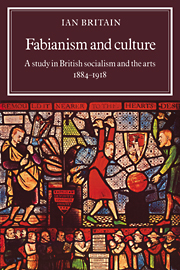Book contents
- Frontmatter
- Contents
- Preface
- List of abbreviations
- Introduction
- PART I THE LITERARY AND ARTISTIC ORIGINS OF FABIAN SOCIALISM
- PART II ART, AUSTERITY AND PLEASURE IN FABIAN SOCIALISM
- 5 The Webb partnership: the practice of renunciation
- 6 The Fabians as anti-ascetics
- 7 Powerhouse or club?: artistic activities of the Fabian Society
- 8 Platform or playhouse?: Fabian lecturing on the arts and the arts of Fabian lecturing
- PART III FABIANISM, ÉLITISM AND POPULAR CULTURE
- Conclusion
- Notes
- Bibliography
- Index
7 - Powerhouse or club?: artistic activities of the Fabian Society
Published online by Cambridge University Press: 29 September 2009
- Frontmatter
- Contents
- Preface
- List of abbreviations
- Introduction
- PART I THE LITERARY AND ARTISTIC ORIGINS OF FABIAN SOCIALISM
- PART II ART, AUSTERITY AND PLEASURE IN FABIAN SOCIALISM
- 5 The Webb partnership: the practice of renunciation
- 6 The Fabians as anti-ascetics
- 7 Powerhouse or club?: artistic activities of the Fabian Society
- 8 Platform or playhouse?: Fabian lecturing on the arts and the arts of Fabian lecturing
- PART III FABIANISM, ÉLITISM AND POPULAR CULTURE
- Conclusion
- Notes
- Bibliography
- Index
Summary
The Fabians' differences over the practice of pleasure in the socialist society of the future were echoed in disputes about their own practices as Fabian socialists. The following issues, stemming in part from those unresolved tensions which led to the schism between the Fabian Society and the Fellowship of the New Life, continued to divide opinion among members — most conspicuously after the ‘second flowering’ of the Society in 1906. What was the chief role of the Fabians as a group, and which of their multifarious interests and activities should become the dominant one in their lives — or at least that part of their lives which they chose to devote specifically to the service of the Society? What weight should be attached to the subsidiary roles of the Society and to the extracurricular activities of members, and what was the nature and extent of the relationship between these and the central concerns of Fabian socialism?
Artistic activities were never as prominent in the group life of the Fabian Society as they were in certain other famous coteries in Victorian and Edwardian England, such as the Pre-Raphaelite Brotherhood or the Bloomsbury Group. Attempts on the part of various Fabians (including several artists or professional critics of art) to give such activities a more overt place in the Society's agenda did not go unchallenged, as this chapter will show. The disputants, however, were at no stage rigidly divided between those members professionally involved in the arts and those who were not.
- Type
- Chapter
- Information
- Fabianism and CultureA Study in British Socialism and the Arts c1884–1918, pp. 163 - 191Publisher: Cambridge University PressPrint publication year: 1982

